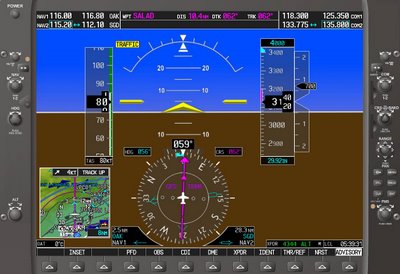Another interesting thing is that the NACO web site lists SIDs as DPs.

In a previous installment, I talked about flying a vectored SID with the G1000. Now it's time to consider a pilot nav SIDs, which are designed to allow the pilot to fly a departure on his or her own navigation with minimal input from ATC.
The only pilot nav SID that I've flown regularly is the Salad One Departure out of Oakland.
Here's a G1000 flight plan from Oakland to Reno, Nevada that uses the Salad One departure. Note that once you have entered your departure and destination airports, the flight plan page on the MFD defines some soft keys along the bottom that allow you to quickly load and select a DP (Garmin doesn't call them SIDs either!), STAR, or instrument approach procedure.

Flying a pilot nav SID is pretty simple. Climb to 400 feet above ground level before making any turns, then fly the headings depicted and intercept the specified course or airway. Here's what the G1000 displays after you've turned to the 092˚ heading and intercepted the Oakland 060˚ radial. The G1000 does what you would expect: It activates the first leg of the SID for you.

Something I recommend to my instrument students is to tune the VORs that define the underlying airways or course for the SID. In the case of an RNAV SID, there may not be any VORs involved. But in this case, there are several VORs that can be set up. In my example, the #1 nav is tuned to Oakland (116.8) and the #2 is tuned to Scaggs Island (112.1) to allow the identification of SALAD intersection. I always recommend being able to identify the first intersection or waypoint on an airway or SID, just in case. In my example, the back-up frequencies are set to allow you to identify the next waypoint, ALTAM, using VORs.

Oh, and you did a RAIM check before departing, right?











